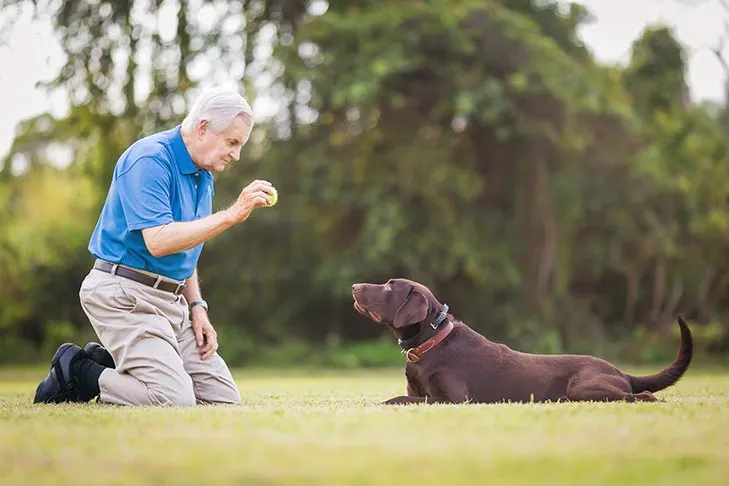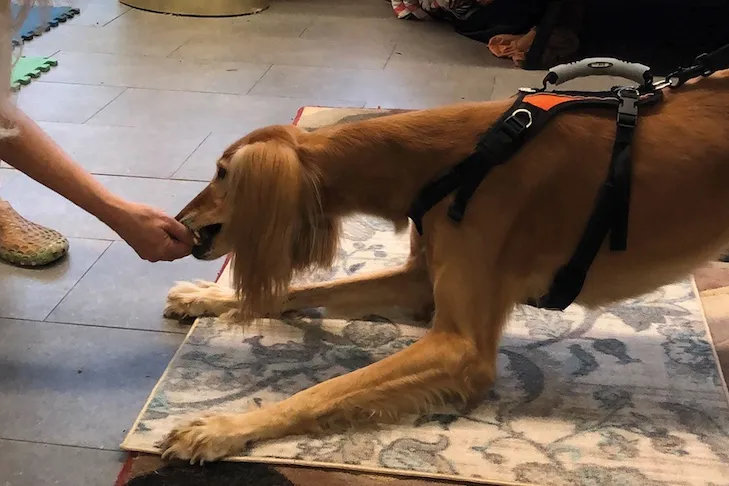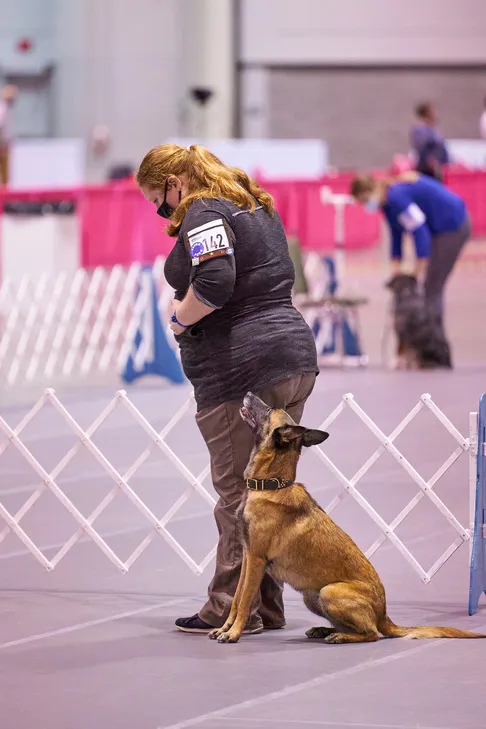Teaching your canine companion new tricks is more than just a way to impress onlookers; it’s a fantastic method to strengthen your bond, provide mental stimulation, and keep your dog engaged. Whether you’re looking to earn titles or simply enjoy some quality time, mastering advanced dog tricks can be incredibly rewarding. You’ll need dedication, a positive attitude, and of course, plenty of dog treats or toys if your dog is particularly toy-motivated. Using a clicker can also be a valuable tool for marking desired behaviors, so have one ready if that’s your preferred method. Finding a calm, distraction-free environment is key to successful training sessions.
If you’re wondering where to start, exploring a comprehensive tricks to teach your dog list can provide a wealth of inspiration. From basic obedience to more complex routines, the possibilities are vast. For those seeking unique challenges, discover unique tricks to teach your dog to truly set your pup apart.
How to Teach Your Dog to Catch
Teaching your dog to catch is a fun and engaging trick that requires patience and positive reinforcement. Start with your dog facing you. Get their attention, then gently toss a treat underhand. If your dog successfully catches it, shower them with praise. If they miss, calmly retrieve the treat before they can eat it and try again.
 A Labrador Retriever sits attentively, ready to catch a tennis ball.
A Labrador Retriever sits attentively, ready to catch a tennis ball.
Repeat this process a few times in each training session. Once your dog consistently catches tossed treats, you can transition to gently throwing lightweight toys they enjoy. Celebrate every successful catch with enthusiastic praise and a tasty treat. This builds confidence and reinforces the desired action.
Mastering the “Under the Bridge” Trick
The “Under the Bridge” trick involves teaching your dog to crawl between your legs. Sit on the floor and form a triangle shape with your knees. Have your dog on one side, and hold a treat or toy in your other hand. Present the treat or toy under your legs, allowing your dog to sniff it.
Slowly guide the treat or toy towards the ground and under your legs. As your dog follows, they will naturally lower their body and move through the space. Once they have successfully passed, offer praise and the reward. After several repetitions, you can introduce a verbal cue like “under” or “bridge” as they perform the action. Eventually, your dog will respond to the verbal cue alone.
Teaching Your Dog to “Speak” on Command
The “speak” trick is often taught using a method called capturing, where you reinforce a natural behavior. When your dog barks out of excitement, immediately mark the behavior with your chosen cue, such as “speak” or “talk,” and reward them with a treat. A clicker is particularly useful here to precisely mark the moment of barking.
 A Dachshund howls, its mouth open in a vocalization.
A Dachshund howls, its mouth open in a vocalization.
With consistent practice, your dog will associate the cue with barking. To prevent excessive barking, it’s crucial to only reward them when they bark in response to your command. This ensures they understand the trick is performed on cue. You can find more helpful tips on training various commands in our dog tricks to teach your dog easy guide.
Introducing the “Leg Weaves” Trick
To teach your dog to weave through your legs, find a secure space without a leash to avoid tangles. Have your dog stand in front of you while you stand with your legs wide apart. Hold a treat behind your legs to encourage them to move through and around. Gently lure your dog between your legs with the treat, praising and rewarding them when they pass.
Once comfortable, use another treat to guide your dog around one leg until they return to the front. As you guide them, let them nibble on the treat to maintain their focus. When your dog successfully navigates around one leg, repeat the process for the other leg. When they can confidently move between and around both legs, start combining the movements to create a figure-eight pattern.
You can gradually fade out the treat lure, using an empty hand to guide them. Once they follow your empty hand, introduce a verbal cue like “weave” or “legs.” As they progress, you can even teach them to weave while you are walking slowly, gradually increasing speed and decreasing step size as they gain confidence. For a structured approach to teaching basic to intermediate tricks, explore our top ten tricks to teach your dog.
Teaching Your Dog to “Shake Hands”
To teach your dog to shake hands, extend your hand towards them. Initially, ignore any licking or sniffing. The moment your dog paws at your hand, mark the behavior with praise or a clicker and offer a treat. Repeat this until your dog consistently offers their paw.
Next, gradually increase the duration your dog’s paw remains on your hand before rewarding them. Start with just a second or two, slowly building up the time as they understand. Once they consistently place their paw and wait for a reward, introduce a verbal cue like “shake” or “hello.” You can then begin to flatten your hand and hold it vertically, introducing a gentle up-and-down motion to mimic a handshake before rewarding.
Teaching Your Dog to Say “Yes” and “No”
This trick gives the illusion that your dog can answer simple questions. To teach “yes,” hold a high-value treat in a closed fist. Slowly move your fist up and down, encouraging your dog to follow with their nose, which will cause them to nod their head. Reward them with the treat.
Once your dog consistently nods, try the same motion without a treat in your hand, rewarding them with a treat from your other hand when they nod. The closed fist will then become the cue for nodding. For “no,” use a different hand signal, like a closed fist with your pointer finger extended. Move your hand slowly from side to side, prompting your dog to turn their head, mimicking a head shake. Reward them when they follow your hand. With practice, the extended finger will be the cue for shaking their head.
Teaching Your Dog to “Bow”
Start with your dog standing in front of you. Get their attention with a treat, then lure their nose down between their front legs, towards their chest. As they follow the lure, they will naturally move into a bow position. Praise and reward them. It’s important to toss a treat away from them afterward to prevent them from going into a full down position.
 A dog in a relaxed bow position, with its front end lowered and rear end elevated.
A dog in a relaxed bow position, with its front end lowered and rear end elevated.
If your dog tends to lie down instead of bow, gently placing a hand or finger on their stomach just below the loin can help cue them that you’re not asking for a down. Once they consistently follow the food lure into a bow, try luring with an empty hand. When they follow the empty hand, introduce a verbal cue like “bow” or “fancy.” With consistent practice, your dog will build strength and coordination to hold the bow longer. You can even evolve the physical cue to you performing a bow or curtsy.
Teaching Your Dog to Make a Circle
To teach your dog to spin, get their attention with a treat or toy. Hold the lure just above their nose and move your hand in a large circle. As your dog follows the lure, they will walk in a circle. Praise and reward them. After a few repetitions, add a verbal cue like “spin” or “twirl.”
To teach them to spin in the other direction, use the same technique. Once they consistently follow your lure in both directions, add the verbal cue for each. When they are reliably responding to the cue in both directions, you can use the circular hand motion without a treat while giving the verbal cue. Reward them when they spin.
Teaching Your Dog to Play “Peekaboo”
The “Peekaboo” trick is useful for maneuvering in tight spaces and keeping your dog close. Stand in front of your dog, facing the same direction. Hold a treat and get their attention. When they come through your legs, praise and reward them.
 A dog playfully peeks out from between its owner's legs.
A dog playfully peeks out from between its owner's legs.
After several repetitions, introduce a verbal cue like “middle” or “peekaboo” as they move between your legs. Use a release cue or toss a treat to move them out of position so you can practice again. As you practice, you can phase out the treat lure, and your dog will begin to respond to the verbal cue to enter the “Peekaboo” position. Learning these tricks not only enhances your dog’s abilities but also provides invaluable mental engagement, contributing to a happier, well-behaved companion.
